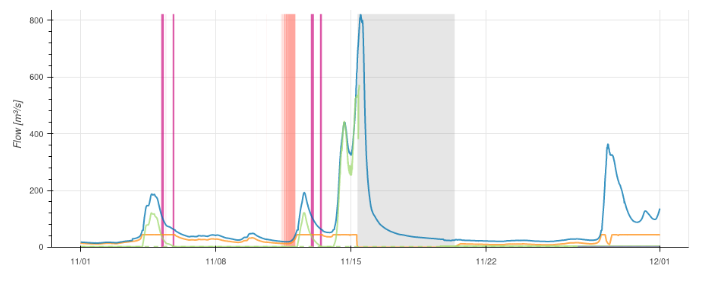Project Purpose
The objective of this project was to support sustainable hydropower operations by developing a near real-time environmental flow compliance monitoring system for 19 run-of-river hydropower facilities across British Columbia. This system ensures compliance with the water license agreement for each facility governing instream flow requirements and flow ramping limitations.
Project Scope and Methodology
Data Collection and Integration
- Site-Specific Compliance Criteria: Each facility has unique compliance criteria for mitigating fish habitat impact based on water use licenses for hydropower operations in British Columbia. Limitations on flow diversion ensure availability of water during critical species' life stages, and flow ramping limitations prevent sudden changes in water levels that could harm aquatic life directly or indirectly by causing erosion or stranding.
- Hydrometric Data Integration: The system collects and analyzes over 120 sensor signals across 19 hydropower facilities to monitor compliance in near real-time.
Web Application Development
- Customizable Information Delivery: Developed a web application to customize the delivery of compliance information. This application allows for tailored reporting and provides quality assurance notes about data collection, which inform field staff responsible for maintaining hydrometric surveys.
- Real-Time Monitoring: Enabled near real-time monitoring of flow data, ensuring prompt detection and reporting of non-compliance events with detailed information about water levels, flows, and hydraulic control system states in the time leading up to and throughout an event.
Compliance Monitoring and Reporting
- Automated Alerts: Set up automated alerts for non-compliance events, significantly reducing the turnaround time for reporting and addressing issues.
- Detailed Reporting: The system generates detailed reports on compliance status, including notes on any detected anomalies.
Event Classification and Analysis
- Operational and Natural Event Classification: Developed simple classification rules to distinguish between non-compliance events due to operational actions, natural phenomena (such as avalanches), and instrumentation issues (e.g., logging errors, sensor calibration).
- Enhanced Data Accuracy: These features enhance the accuracy of compliance monitoring and improve the reliability of the data.
Continuous Improvement and Maintenance
- Ongoing Support: Continually maintain and update the web application to ensure its effectiveness and reliability.
- Improved Communication: The project fostered improved communication between operations and environmental staff, contributing to a culture of collaboration and proactive compliance management.
Project Outcomes
- Efficient Compliance Monitoring: The implementation of the WAVE system resulted in substantial reductions in the turnaround time for reporting non-compliance events.
- Enhanced Communication: The project facilitated efficient communication between operations and environment staff, fostering a culture of transparency and collaboration.
- Improved Data Management: The web application’s customizable features and quality assurance notes have improved data management and the information available for field staff.
- Reliable Event Classification: The incorporation of event classification features has improved the accuracy and reliability of compliance monitoring, distinguishing between operational actions, natural phenomena, and instrumentation issues.
This project successfully provided a robust solution for environmental flow compliance monitoring, ensuring sustainable hydropower operations and fostering a proactive approach to environmental stewardship.
